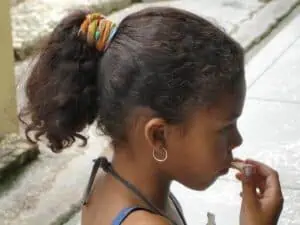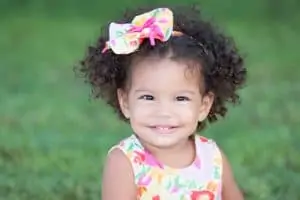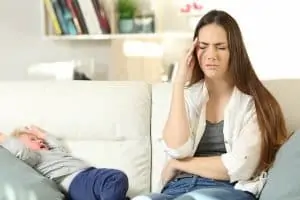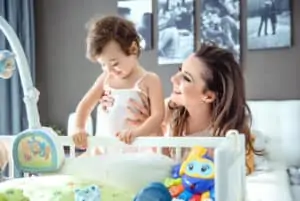Have you ever tied your hair up into a tight ponytail for the gym, or perhaps to keep it well away from the water when going swimming? It’s not comfortable, is it?
Well, of course, it’s not. And if that’s what you’re doing to your daughter’s hair, you can expect to hear her complain that it hurts or that she has a headache.
It’s worse for kids because their tender hair grows from that fuzzy baby stuff to thicker hair. But if you’re tying ponytails, buns, and other tight styles in there all the time, you’re damaging her hair.
That’s not to say you can NEVER put her hair up. You just need to be careful about it (more on that in a moment).
The biggest problem with always putting those severe styles in your child’s hair is that it can cause hair loss. Known as traction alopecia, it is caused by repeatedly pulling the roots of the hair in the same way for hours or days at a time. The hair near the temples and along the hairline is most prone.
And you might not even notice the thing since it tends to happen gradually. Then the bald patches appear.
This tends to be even more common for Black girls because of the types of pulled hairstyles like braids, dreadlocks, cornrows, or extensions. As African hair is more brittle, it can be more susceptible to damage from the intensive pulling of the hair into these styles. But this can happen to any little girl who wears her hair in a too-tight style too often, no matter her background.
Headbands, hair rollers, and tight headgear may also cause traction alopecia, so we all, as moms, must watch how we style our children’s hair. And if they’re old enough to style it themselves, help them understand how their chosen styles could impact their hairline.
The longer the hair, the more pulling it will do in a tight ponytail. This weighs on the scalp and can cause hair loss.
But how does this happen?
It’s a result of repeated pulling in the same direction. If you look closely at the damage, you can see the affected areas have hair of varying lengths. The follicles can also become inflamed, which can cause weakened hair growth, resulting in shorter, more delicate hair.
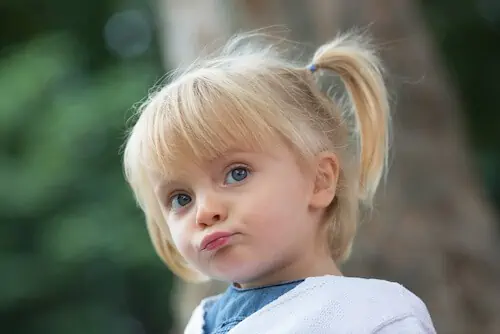
You want to avoid doing this to yourself or your daughter, for if those hair follicles become scarred, they will be permanently damaged, and you’ll suffer permanent hair loss.
What to look for
Don’t worry if you’ve only given your daughter one or two tight ponytail styles in her lifetime. But from now on, be vigilant to avoid doing so. If you’re concerned about repeatedly styling her hair in a tight bun or ponytail, perhaps for dance class, look for the common symptoms of traction alopecia on the scalp.
- Bumps
- Redness
- Stinging and/or soreness
- Scaling
- Crusting
- Itching
- Pustules
You’ll want to keep an eye on the hairline for these things, though other parts of the scalp can be affected too.
Relevant: Doing ponytail in short toddler hair.
What you can do
To prevent this kind of damage, here are some tips that will help you safely style your toddler’s hair with ponytails and in other up ‘do’s.
- Change it up
Don’t put the same style in your toddler’s hair every day. Alternate between ponytails and wearing it down.
- Never use elastic
Elastic bands and rubber bands are the kiss of death for healthy hair. Choose ties that don’t tug and pull out hair. My post about ponytails from a while back has some excellent options that are safe for hair.
- Do thicker instead of thinner braids
Go thick if you’re doing French braids or other kinds of braids. Thinner braids will pull the hair more and cause more damage.
When it comes to treating traction alopecia, you’ll need to take your child to a dermatologist to have her scalp examined. This should be done if you haven’t seen an improvement with changing the hairstyles. Hopefully, this will help keep your toddler’s growing hair healthy and free of damage before anything major happens!
Leslie Berry lives with her husband and two young daughters in Los Altos, California, where she loves helping other moms get comfortable with motherhood and embracing the insanity with facts peppered with laughs.
She loves eating too much sushi, exercising, and jamming out on her Fender. Read more about Leslie here.


